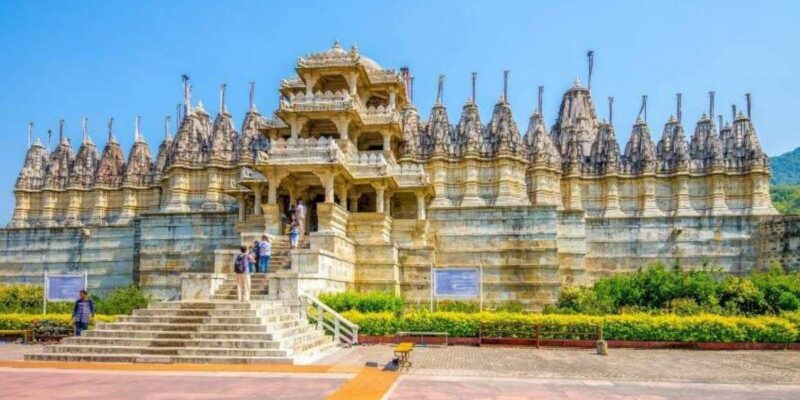
Introduction
Nestled amidst the Aravalli hills in Rajasthan, India, the Dilwara Jain Temple complex stands as a testament to exquisite craftsmanship and architectural brilliance. Renowned for its intricate carvings and serene atmosphere, this temple attracts pilgrims and tourists alike from around the globe.
Historical Background
The history of Dilwara Jain Temple dates back to the 11th-13th centuries when it was built by Chalukya rulers. It holds immense significance in Jain history, serving as a place of worship and spiritual retreat.
Architectural Overview
The Dilwara Jain Temple complex comprises five major temples, each unique in its architectural style and design. The temples are renowned for their marble architecture, which showcases a blend of simplicity and ornate detail.
Design and Layout
Layout of the Main Temples
The layout of Dilwara Jain Temple complex is structured around a central courtyard, leading to various shrines dedicated to different Jain Tirthankaras. Each shrine is intricately connected, forming a cohesive architectural marvel.
Intricate Carvings and Sculptures
One of the most striking features of Dilwara Jain Temple is its intricate carvings and sculptures. The marble panels depict scenes from Jain mythology, floral motifs, and geometric patterns, showcasing the unparalleled skill of artisans.
Detailed Architecture of Each Temple
Vimal Vasahi Temple
Structure and Design Details
Vimal Vasahi Temple, dedicated to the first Jain Tirthankara, Lord Adinatha, exemplifies Maru-Gurjara architecture. Its central dome, adorned with sculpted figures and ornate motifs, reflects the pinnacle of medieval craftsmanship.
Carvings and Motifs
The temple interiors are adorned with delicately carved marble panels that narrate Jain teachings through intricate details. Each carving is a testament to the devotion and skill of the craftsmen of that era.
Luna Vasahi Temple
Architectural Highlights
Luna Vasahi Temple, dedicated to the 22nd Jain Tirthankara, Lord Neminatha, showcases a more refined architectural style with detailed ceiling carvings and pillars. Its aesthetic appeal lies in the harmonious blend of geometric precision and artistic expression.
Decorative Elements
The temple’s sanctum sanctorum is adorned with celestial beings and mythical creatures, sculpted with precision to create a divine ambiance. The marble used in Luna Vasahi Temple reflects light in a unique way, enhancing its spiritual aura.
Techniques and Construction Methods
Techniques Employed in Construction
The construction of Dilwara Jain Temple involved meticulous planning and innovative techniques such as interlocking marble slabs without the use of mortar. This engineering marvel ensures the structural integrity of the temples even centuries later.
Role of Craftsmanship
Craftsmen employed by the Chalukya dynasty played a crucial role in shaping the architectural landscape of Dilwara Jain Temple. Their expertise in sculpting marble into intricate forms remains unparalleled, making the temples a timeless marvel of artistry.
Symbolism and Religious Significance
Symbolic Elements in Architecture
Every facet of Dilwara Jain Temple’s architecture symbolizes Jain principles of non-violence, truth, and compassion. The temples’ symmetry and purity of design reflect Jain beliefs in leading a harmonious and disciplined life.
Jain Principles Reflected in Design
The temples’ architecture encourages introspection and spiritual contemplation, with each sculpture and motif conveying deeper philosophical meanings. Visitors experience a profound connection with Jain teachings through the visual narrative of the temple’s design.
Comparison with Other Jain Temples
Contrasts and Similarities
Compared to other Jain temples in India, Dilwara Jain Temple stands out for its sheer grandeur and intricate detailing. While other temples may share architectural motifs, the precision and scale of Dilwara temples set them apart as a marvel of medieval architecture.
Unique Features of Dilwara Jain Temple
Unlike many other Jain temples, Dilwara Jain Temple’s interiors are devoid of any metal or wooden supports, relying solely on marble craftsmanship for structural strength. This unique feature underscores the temple’s architectural ingenuity and durability.
Also Raed Big Savings on Kids Must-Haves at ENGINE
Conservation Efforts and Challenges
Preservation Initiatives
Efforts are underway to preserve Dilwara Jain Temple’s architectural heritage through restoration projects and conservation measures. Specialized teams work diligently to maintain the pristine condition of marble carvings and prevent environmental degradation.
Challenges Faced in Maintaining Heritage
Challenges such as weathering due to climatic conditions and increasing tourist footfall pose significant threats to the temple’s delicate marble surfaces. Conservationists strive to strike a balance between accessibility for visitors and preservation of cultural integrity.
Visitor Experience
Impact on Tourists
Visitors to Dilwara Jain Temple are awe-struck by its serene ambiance and architectural splendor. The temple complex offers a spiritual retreat and an opportunity to witness centuries-old craftsmanship up close, leaving a lasting impression on all who visit.
Cultural Significance
Dilwara Jain Temple not only serves as a religious landmark but also as a cultural icon that embodies the rich heritage of Rajasthan. Its architectural beauty transcends time and continues to inspire artists, architects, and historians worldwide.
Architectural Influence
Influence on Regional Architecture
The architectural style of Dilwara Jain Temple has influenced subsequent developments in regional architecture, particularly in the use of marble and intricate carving techniques. Its legacy continues to shape contemporary interpretations of traditional Indian temple architecture.
Global Recognition
Internationally acclaimed for its architectural finesse, Dilwara Jain Temple has garnered recognition as a UNESCO World Heritage Site, highlighting its universal significance as a cultural and architectural treasure.
Conclusion
In conclusion, the architecture of Dilwara Jain Temple represents a harmonious blend of spiritual symbolism and artistic expression. Its intricate carvings, innovative construction techniques, and profound cultural significance make it a jewel in India’s architectural crown.










